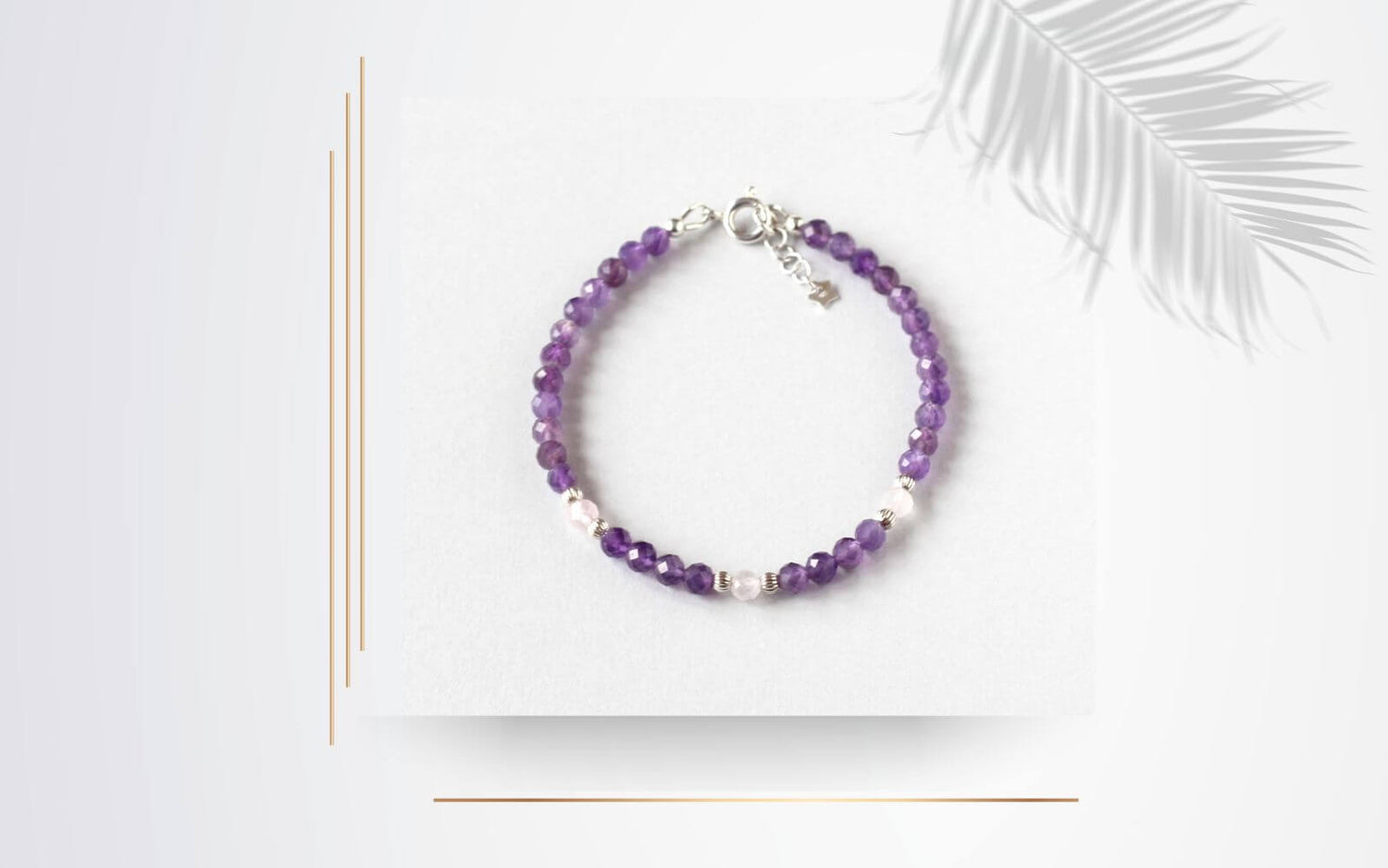
Amethyst Unveiled: A Journey into the Depths of Purple Majesty
Amethyst Unveiled: A Journey into the Depths of Purple Majesty
Admired for its stunning violet hues and metaphysical properties, Amethyst has been cherished for centuries earning its place as one of the most beloved gemstones in the world. In this blog post, we explore its formation, uncover its profound symbolism, understand its healing properties and unravel the myths around this purple gemstone. It is one of our favourite gemstones to work with. We have Amethyst pieces in our collections that look gorgeous on their own or paired with Rose Quartz.
Did You Know?
- Amethyst is the February birthstone and the gemstone for the 6th wedding anniversary. It is thought to bring balance and clarity to those born in February, making it a popular and meaningful choice for birthday gifts.
- Amethyst is the stone of Saint Valentine, the patron saint of romantic love. According to legend, he wore an Amethyst ring carved with the image of Cupid.
- Colour transformation - Amethyst exhibits a fascinating phenomenon known as pleochroism., The gemstone can display different colours when viewed from different angles. While the primary colour is purple, some crystals may show flashes of red or blue when rotated. This optical characteristic adds an extra layer of intrigue to the gemstone, making each specimen unique.
- Royalty's gemstone - Amethyst has long been associated with royalty and nobility throughout history. In ancient times, it was considered more precious than diamonds. It adorned the crowns and rings of many monarchs.
- The sobriety gemstone - The name “Amethyst” comes from the Greek word “amethystos,” which translates to “not drunk.” The ancient Greeks placed Amethyst in drinking vessels because they believed it would prevent or reduce drunkenness.
Formation of Amethyst
Amethyst, a member of the Quartz family that also includes gemstones like Citrine and Rose Quartz, traces its origins to the depths of the Earth. It is typically formed in geodes. Amethyst crystals thrive in cavities within volcanic rocks or the hollow spaces created by gas bubbles in ancient lava flows. The unique colouration of Amethyst, ranging from delicate lavender to deep violet, arises from the presence of iron and other trace elements within its crystal lattice. Exposure to natural or artificial heat can alter its colour, resulting in unique variations that add to its allure.
Meaning and Symbolism of Amethyst
The name "Amethyst" is rooted in ancient Greek, with "amethystos" meaning "not drunken." According to Greek mythology, this gemstone was believed to possess the power to prevent intoxication, making it a symbol of sobriety and clear-headedness. This belief is reflected in the practice of ancient Greeks and Romans who often crafted wineglasses from Amethyst to safeguard against overindulgence.
Beyond its historical roots, Amethyst carries diverse meanings across cultures. In Christian symbolism, it is associated with piety and is considered one of the twelve foundation stones of the New Jerusalem. In Tibetan Buddhism, the gemstone is revered and represents the energy of the Buddha.
Amethyst is also celebrated for its association with royalty and nobility. Adorning the crowns and jewellery of monarchs throughout history, Amethyst symbolises power, wisdom, and spiritual insight. Today, it continues to be a popular choice for jewellery, bringing a touch of regal elegance to contemporary designs.
Healing Properties of Amethyst
Beyond its aesthetic appeal, Amethyst is celebrated for its spiritual and healing properties. In the realm of alternative medicine and crystal healing, it is often considered a gemstone of tranquillity and balance. It is said to calm the mind, soothe emotional turbulence and alleviate stress.
Associated with the crown chakra, Amethyst is believed to enhance spiritual awareness and promote a connection to higher realms. Meditating with the gemstone is thought to open channels of communication with one's inner self.
Amethyst is also admired for its protective qualities, acting as a shield against negative energies.
Myths and Legends
Myths and legends have long surrounded Amethyst, adding to its appeal. One such legend originates from ancient Greece. It tells the story of Dionysus, the god of wine, and a young maiden named Amethystos. To protect her from the advances of Dionysus, Amethystos prayed to the goddess Artemis, who transformed her into a pure crystalline form – the gem we now know as Amethyst.
In another myth, the ancient Egyptians believed that Amethyst possessed protective qualities against evil forces and used it in amulets and talismans. This belief in the gemstone’s protective powers persisted through various cultures and centuries, setting its reputation as a guardian against negative energies.
Caring for Your Amethyst
Amethyst is a relatively durable gemstone rating 7 on the Mohs’ scale of hardness. It is still important to treat it carefully to maintain its beauty over time. Direct sunlight can cause its colour to fade over time. Chemicals can damage the surface of the gemstone and affect its appearance. Keep Amethyst separate from other gemstones and metals to prevent scratches. Use a soft brush or cloth to clean the gemstone. You can also use mild soap and warm water. Avoid using ultrasonic cleaners or steam cleaners as they may damage the gemstone.
Amethyst, with its radiant hues and rich history, stands as a testament to the enduring fascination humans have with gemstones. Whether cherished for its aesthetic beauty, healing properties or symbolism, Amethyst remains a gemstone of timeless allure, inviting us to explore the enchanting world within its purple depths.
Discover Our Amethyst Collection

References:





